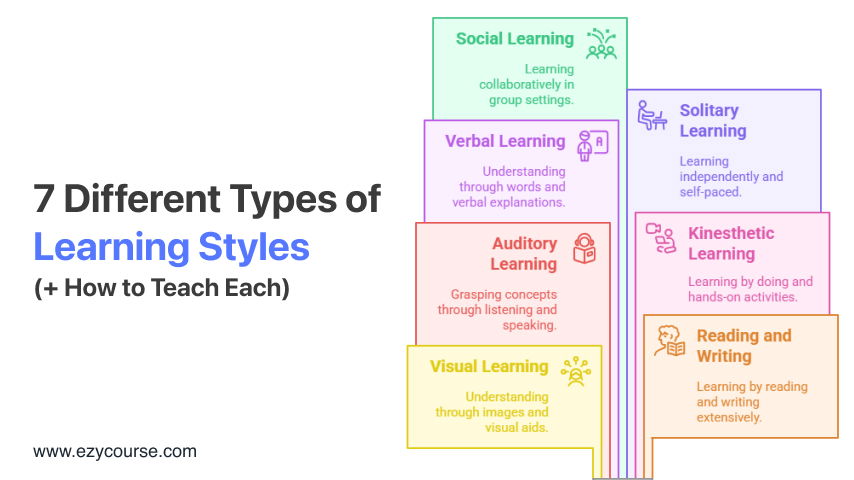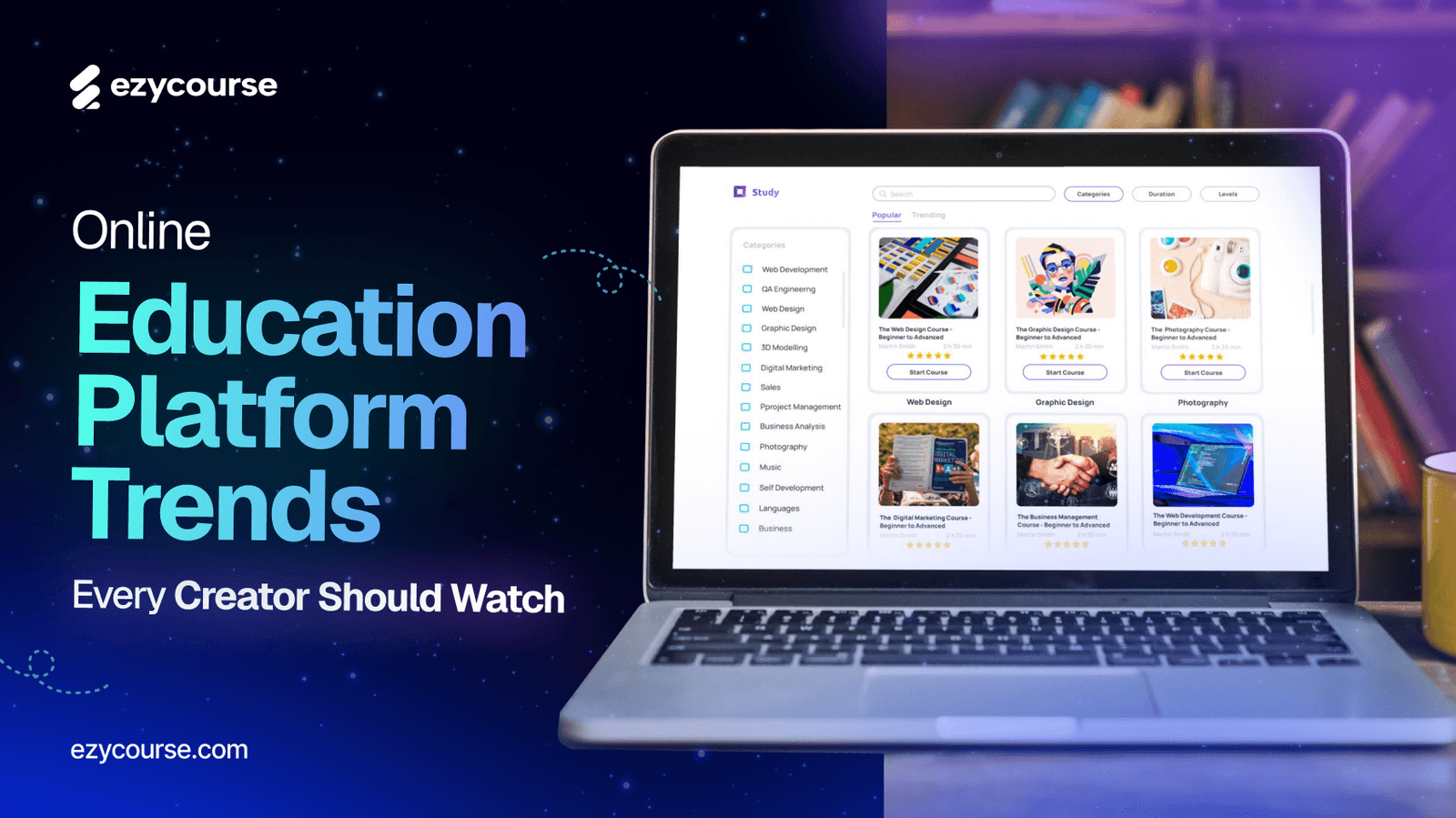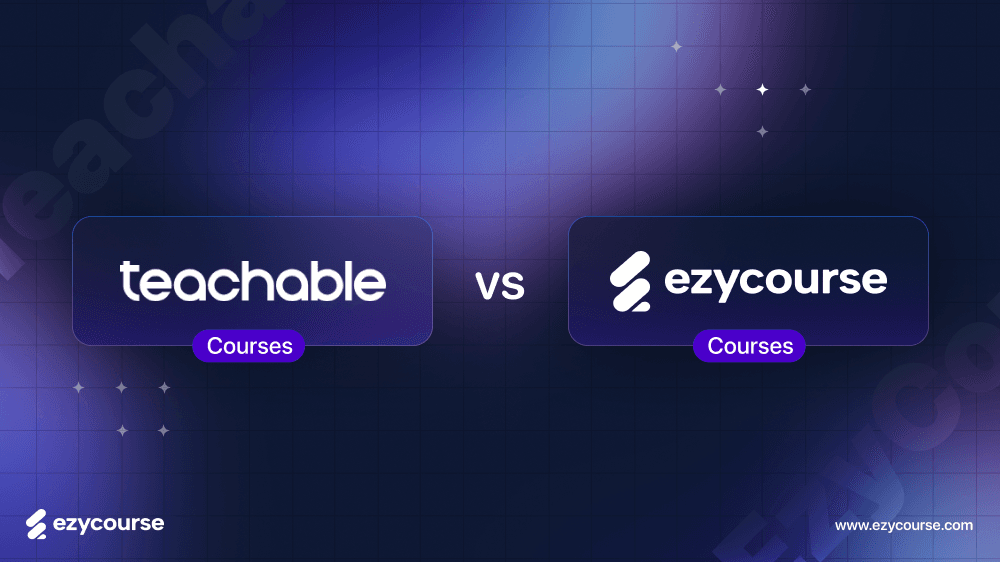You've probably heard that we all learn in different ways. This concept is related to the theory of different types of learning styles. It states that each person has a preferred way to absorb and retain new information. These seven styles are based on senses or social habits and include:
Visual
Kinaesthetic
Auditory
Social
Solitary
Verbal
Reading and writing
The idea behind the theory is that by teaching someone through their strongest learning style, they will learn more quickly and effectively. It sounds smart, but new research shows it doesn't work that way.
Recent studies say this theory is a neuromyth. The Guardian explains that it can create false beliefs about how someone learns, which may hold them back in the long run.
In truth, putting learners into boxes doesn't help much. Most people do better when they use a mix of learning methods. Utilizing different learning styles can enhance flexibility and improve our learning abilities.
However, in this guide, we will reveal different types of learning styles. Keep going.
Definition of Learning Styles
People learn in different ways. Some like to see things. Others learn by hearing, doing, or reading. All these are learning styles.
However, you can help your students learn more effectively by understanding their learning styles. You can create lessons that fulfill how students learn best. That makes learning more fun and less stressful for them.
Most experts agree that there are approximately four to seven different types of learning styles which you can (as an educator) align with your teaching styles.
Also, one student can use more than one style. These are called multimodal learners. They remember things better when they mix learning styles.
The 7 Different Types of Learning Styles
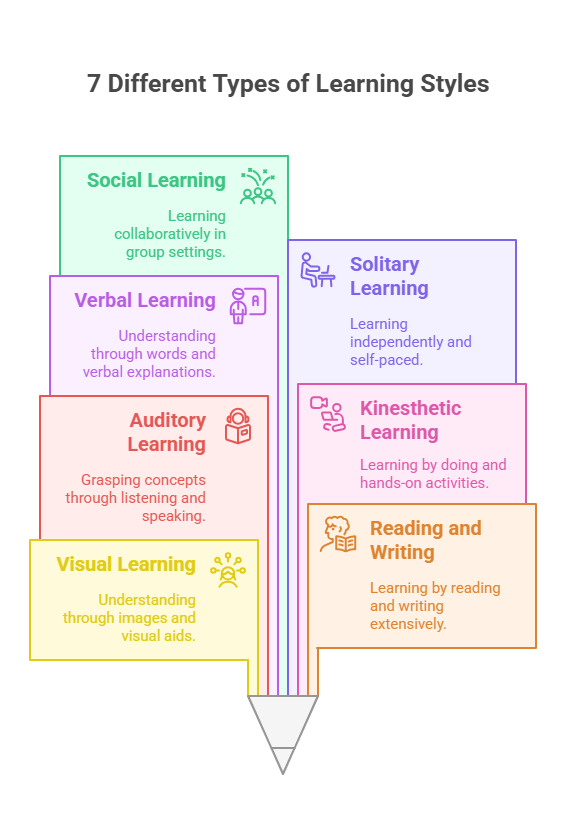
In 1987, a New Zealand teacher named Neil Fleming developed a simple way to explain how people learn. He called it the VARK model. This model illustrates four primary learning styles: Visual, Auditory, Reading/Writing, and Kinesthetic. The first letters make up the name "VARK." While learning style theories like VARK are often debated in education research (APA), course creators still find them useful frameworks for diversifying content delivery and improving engagement.
We'll examine these four learning styles and three additional ones that experts later identified.
1. Visual Learning
Many people learn best by seeing things. A 2019 study found that approximately 65% of people are visual learners. That means most of your students might prefer visual tools in your lessons.
These learners understand better when they see things like:
Pictures
Charts
Graphs
Diagrams
Infographics
Slideshows
Videos
Maps
Flashcards with images
Whiteboards or animations
But don't use them all at once! Pick the best visual for the topic you're teaching. Less is more when it comes to helping visual learners.
Video lessons work great for this group. If you're new to video making, there are simple guides and tools available to help you get started. Slideshows with voiceover are also a good option.
Visual learners also enjoy reading and writing, but they often highlight notes, draw images, or add graphs to help them remember. You can support them by giving printable notes or downloads they can write on. If you use platforms like EzyCourse, it's easy to add these extras.
Some teachers incorporate different learning styles into a single course. They teach students through a combination of videos, live drawings, and printable workbooks. The combined style of learning is also great for students with different types of learning styles. Everyone has their way of learning.
2. Reading and Writing Learning
Some students learn best by reading and writing. They like books, notes, and written work. This group is similar to visual learners, but they tend to focus more on words than images. Sometimes these learners also look for ways to practice writing more effectively outside of class, and tools like DoMyEssay can help them review structured examples or improve their study habits without interrupting their natural learning workflow.
Here are a few good ways to teach them:
Textbooks and handouts
Blogs and articles
Essays and quizzes
Written guides and instructions
Workbooks and study sheets
You can also add simple tools to help your students. Try making a short e-book. If your course includes videos, provide written words to follow along. This allows them to read and take notes while they watch.
3. Auditory Learning
About 30% of people learn best by hearing things. These are called auditory learners. They understand more when they listen instead of reading or watching.
They enjoy things like lectures, podcasts, music and videos with sound. Many auditory learners read their notes aloud or study with music playing in the background. They remember things better that way.
To support this learning style, you can:
Add songs or music to explain ideas
Give audio versions of your notes.
Let students discuss what they have learned.
Think about your subject, too. For example, if you teach guitar, sound is key. You can mix audio with visuals, like showing how to play each note. This helps students with different learning styles.
4. Kinesthetic Learning Style
Kinesthetic learners retain information best through hands-on experiences. Learners move, touch, and try things out to learn. This learning method emphasises hands-on action.
These learners enjoy games, puzzles, and real tasks. They enjoy solving problems and trying new things. It helps them remember better and stay focused.
Many people think this type of learning only works in person. However, you can also support kinesthetic learners in online courses.
For example, coding classes often include hands-on tasks, such as coding challenges or small projects. These provide students with an opportunity to learn through hands-on experience.
The kinesthetic learners can learn more effectively by following the simple ways:
You should take short breaks during long lessons.
Add tasks that students can do at home. A plant course, for example, might include planting a real plant.
Assign real-life problems and encourage project-based learning.
Include movement when possible. Yoga, dance, or fitness-related online courses are perfect for this.
Use printables or send supplies to students. This adds a physical element to your course.
There are many different ways to learn, and this type is characterised by its energy and action. One great example is the Hands-on Kids Activities Club (HOKA).
Teachers get monthly downloads and tools to create fun, hands-on lessons. In one lesson, students learn about a famous artist and then make their own art in that style.
5. Verbal or Word-Based Learning
Some people learn best with words. They remember things by speaking and hearing them. This is called verbal or word-based learning.
These learners often talk to themselves while studying. They enjoy reading, writing, and telling stories. Many love poems and word games, too.
Here are a few things that help them learn:
Listening to talks
Using flashcards with words
Speaking out loud
Playing word games
Watching word-based lessons
If you teach English, Spanish, or any other language, these learners will want to hear and repeat the words.
6. Solitary or Independent Learning
Some people learn best alone. They prefer quiet time and dislike group work. This is called solitary or independent learning.
These learners often think a lot. They stay focused and like working at their own pace. Talking in groups can make them feel tired or stressed.
You can help them in the following ways:
Ask simple questions to get to know them.
Let them work on their own.
Tell them why the task matters. They like to see the big picture.
Solitary learners are usually very driven. They don't wait for help, they just start and keep going. That's a strong skill.
Still, it's good to remind them that learning from others can help too. Try offering quiet one-on-one chats. They may feel safer asking questions that way.
These learners don't need a crowd. They just need space, trust, and support. And when they feel understood, they can do amazing things.
7. Social or Group Learning
Some students learn better than others. They enjoy talking and working in groups. This is called social or group learning.
These learners love to share ideas. They enjoy asking questions, providing feedback, and collaborating on projects. They feel happy when they learn with others.
Here's what helps them:
Group talks and teamwork
Partner study
Flashcard games with a friend
Giving and getting tips
Showing their work to a group
This type of learning is full of energy. People who learn in this way tend to enjoy being around others. It's one of the many different ways to learn, and it makes learning feel fun and friendly.

How to Find Out a Student's Learning Style
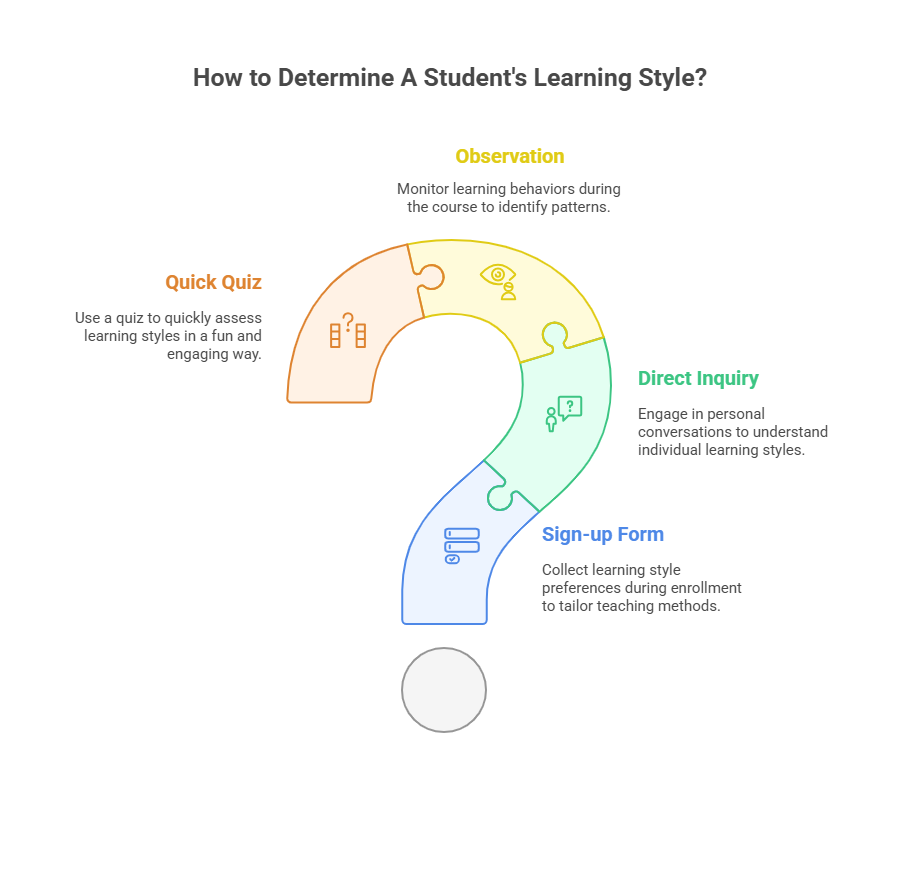
Most adults already know how they like to learn. You can ask students or coaching clients about their learning styles when they sign up. It helps you teach them better.
Here are simple ways to find out their learning style:
Add a short form to your sign-up page
Ask them directly when they join.
Watch how they learn during the course.
Give them a quick quiz or activity.
You can use tools like the VARK quiz online. Or you can make your quiz based on your course. Keep it simple and fun.
You can include the following easy questions.
Do you like to study alone or with others?
Do pictures help you understand things better?
Do you remember things better when you see or hear them?
Would you rather take something apart to learn how it works?
Do you learn more by reading or by listening?
Let students know there are no wrong answers. The quiz is just to help you understand them. This way, you can match your teaching to their learning style.
These quizzes are well-suited for group coaching programs or online classes that have set start dates. They help you adjust your lessons for each group or offer more personal support.
Related Read: How to Make Online Classes More Interactive
How to Teach Different Types of Learning Styles
When creating a course, consider how each student learns. Some like to listen. Some like to read. Others need to do things with their hands. No one way works for everyone.
For example, students who like talking may enjoy group chats. However, students who enjoy reading may need time to reflect before they can fully engage with the material. Talking right away can feel hard for them.
You can help both. Give the topic early. This way, reading learners can write notes. Then, they'll feel ready to join the talk. Listening learners still get the group chat they enjoy.
When you teach in multiple ways, all students feel seen and valued. They learn better. And they enjoy the course more. That's what good teaching is all about.
How to Make an Online Course for All Type of Learners
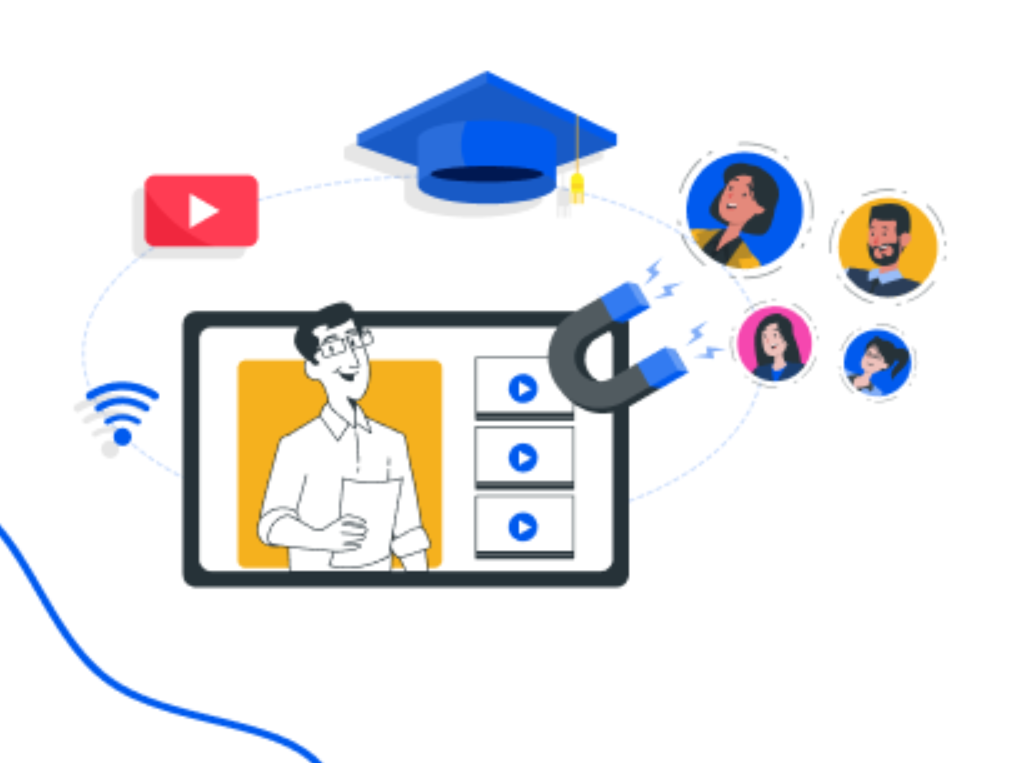
Want to teach online and earn money?
Great! First, you need a place to build your course.
EzyCourse is a great all-in-one online coaching platform for that. It's simple to use and works well for all learning styles. You can add videos, audio, slides, quizzes, and projects. You can teach live or record your lessons beforehand. Do what feels right for you.
The best part? You don't need to know coding. Simply select a design, drag elements where you want, and you're done. It only takes a few hours.
Try it out. You'll see how easy and fun it is to build a course that works for everyone.

Teaching for All Learning Styles

Good teaching works best when it's flexible. As there are different types of learning styles, using just one way to teach doesn't help everyone. You should mix up your methods to double the impact.
Start by planning. A great way to reach more students is by using Universal Design for Learning (UDL). This means you show and say things. That way, all students can understand, regardless of their learning style.
Here are some simple ways to help all learners:
Use extra tasks for early finishers so you can help others who need assistance.
Give clear steps and short time limits.
Let students take turns helping each other.
Use colour to group students or tasks effectively.
Add sounds, pictures, and hands-on tools to lessons.
How your classroom is set up matters, too. Moving seats or trying group work can make a big difference. However, remember that students don't always adhere to one style. It depends on the subject. So, stay open and ready to adjust.
Technology can help a lot. Some tools track students' progress and provide immediate feedback. This enables you to adjust your teaching in real time to meet their needs.
Let students be active. Group talks, games, and team projects help many learners. However, short talks or demos can still be helpful when things get tricky or confusing.
Don't just give tests that check memory. Try asking students to demonstrate what they've learned in their own way, such as through a project, a story, or a drawing. Match the task to how they learn best.
You can adjust four things: what you teach, how you teach it, what students do, and where they learn. Watch how they work. Do they like drawing, talking, or reading? Use that to guide your next steps.
Check-in with your students often. Ask what's working and what's not. Watch how they grow, and be ready to change your style as needed. When you care about how they learn, they feel it, and they do better. Again, you can create and run live webinars for your students to boost more interaction.
Some More Types of Learning Styles
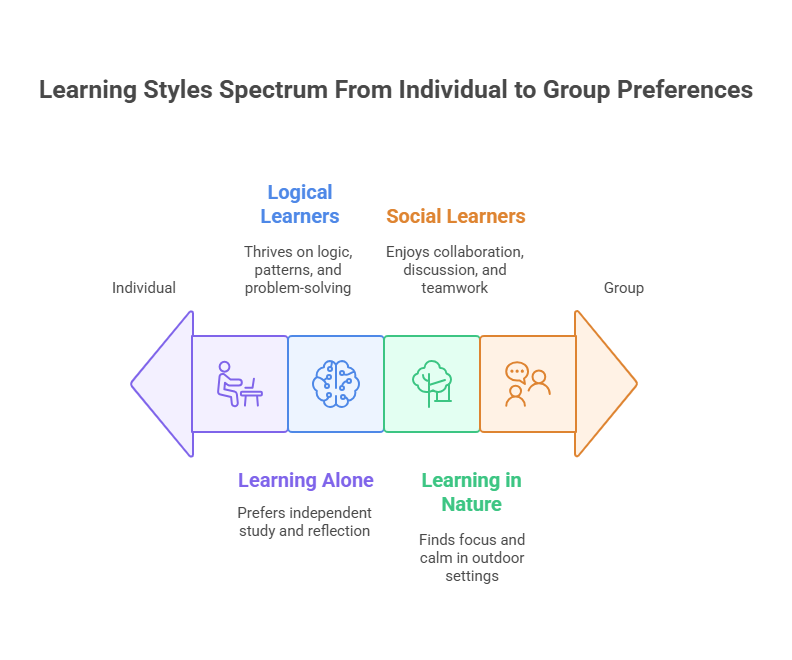
We've already talked about the most common learning styles. Now, let's examine some lesser-known types of learning styles. Experts still debate the number of learning styles that truly exist. Some say there are just a few. Others believe there could be over 100!
Here are four more learning styles based on thinking and social skills:
Logical or Analytical Learners
These learners are drawn to patterns, facts, and problem-solving. They ask "why" and "how" a lot. They attempt to make sense of things by seeking connections and clear answers.
To help these learners, teachers can:
Ask questions that make them think
Use real-life problems to solve
Let them find answers by using logic and reasoning.
Social or Linguistic Learners
These learners enjoy working with others. They prefer group work and discussing things together. They learn better when they share ideas and ask questions.
To support them, teachers can:
Use role-playing or partner work
Encourage group talks and storytelling.
Let students learn through teamwork and social tasks.
Learning Alone
Some students learn best alone. These are solitary learners. They like to work by themselves. Group work can feel tiring for them. Quiet time helps them think clearly.
Teachers can help by:
Giving solo tasks
Letting them keep a journal
Noticing and praising their hard work
Learning in Nature
Another type is the natural learner. These students feel calm and focused when they are outside. Fresh air and nature help them learn better. They enjoy quiet, green places.
Nature learners are similar to hands-on learners, but they require an outdoor setting. It helps them feel relaxed and ready to learn.
Teachers can support them by:
Taking a class outside when possible
Using real nature examples in lessons
Giving tasks like planting or exploring
Every student learns in their own way. Some need space. Some need nature. A little understanding can go a long way.

Why Learning Styles Are Important
Now that you know about different types of learning styles, let's talk about why they matter for you and others at work.
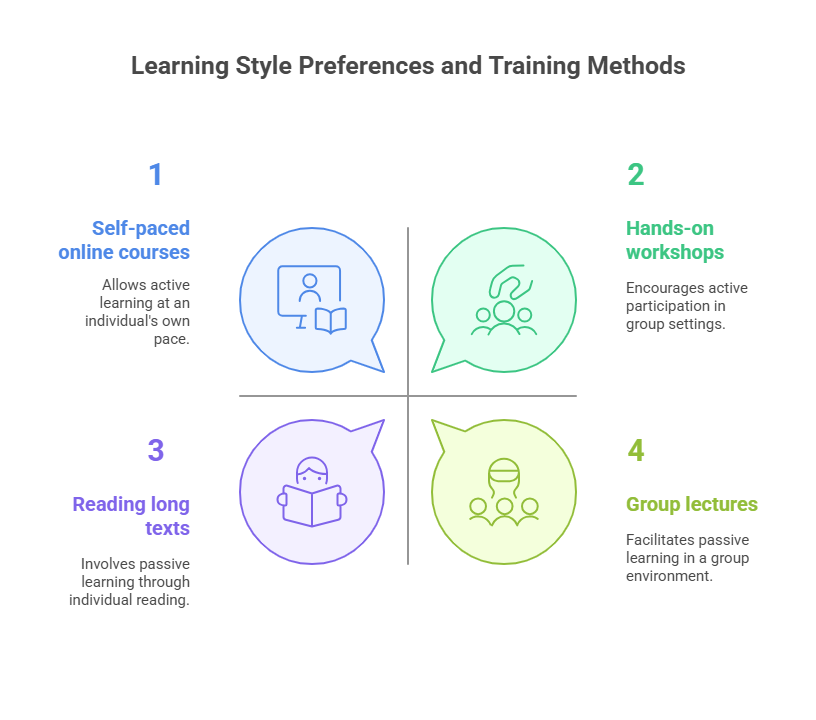
For Your Growth
Knowing how you learn best can be extremely helpful. It makes training easier and more fun. You remember more and feel more confident. Moreover, you can also use what you learn in real life.
For example, if you're a visual learner, try using pictures or videos instead of reading long texts. If you learn by listening, use podcasts or voice notes. If you prefer quiet time, consider studying alone at your own pace.
For Training at Work
People at work all learn in different ways. When you understand this, you can develop more effective training. Utilize various tools to ensure everyone feels included.
A hands-on learner may prefer to learn by doing real-world tasks. Someone who prefers to work alone might appreciate an online course that allows them to work in a quiet environment. When you offer different ways to learn, everyone wins.
Even small changes can help. Add subtitles to videos. Mix online and in-person sessions. Give people choices.
When learning aligns with an individual's learning style, training and online courses become more effective and more enjoyable.
How to Support All Learning Styles Online
When you build your first online course, don't just upload a few videos and think it's done. Take time to plan how your course will flow from start to finish.
Think about how you explain new ideas. Decide when students should pause and think. Add simple activities to help them remember what they just learned. People learn in different ways, so building your course with that in mind can help them achieve better results.
Here are a few tips to incorporate elements that meet the needs of every learning style, or at least maintain a balanced approach.
Visual learners
People who learn by seeing require visual aids, such as pictures and diagrams, to understand concepts better. Here's how to make your online course easier for them:
Add photographs, sketches, and drawings to show ideas.
Use flashcards for reviews and quick checks.
Create charts or maps to organize topics.
Colour-code notes to make key ideas stand out.
Compare topics with easy-to-read color tables.
Use a whiteboard in videos to show key points.
Let students change fonts and sizes to make reading easier
Reading and Writing Learners
Reading and writing learners learn best through reading and writing. They like using words and enjoy reading materials or writing things down. Here's how to teach them well:
Ask students to write short lesson summaries.
If you're teaching literature or language, have students read stories aloud to one another.
Add written transcripts to your videos.
List key points and ideas to help them remember.
Provide notes and checklists that can be downloaded and studied.
Share useful links to blogs or helpful articles for more reading
Use small movements like snapping or pacing to help with memory during reading or reciting
Auditory and Verbal Learners
Auditory learners understand best when they hear things. Spoken lessons, clear instructions, and conversations help them learn. Here's how to make your course fit their needs:
Discuss each topic with your students.
Ask questions aloud and have students respond verbally.
Let students record your lessons and replay them later.
Share short readings for them to listen to while reading along.
Explain your steps, thoughts, and answers as you guide your students through the lesson.
Ask students to give short oral summaries of what they've learned.
If you're teaching math, try using a talking calculator.
Create audio lessons that can be listened to anywhere.
Make videos of yourself explaining the lessons.
Add a podcast or a YouTube video that relates to your topic.
Host a live Q&A session so students can engage in discussions and learn from you and others.
Kinesthetic or Tactile Learners
Some people learn best by doing things. These are hands-on (kinesthetic) learners. They enjoy touching, moving, and trying things out for themselves. Just watching or listening is not enough for them. Try these tips to help them learn better:
Let them write using different types of paper, pencils, or pens.
If you teach words or language, ask them to use new words when talking to others.
Have them act out ideas from the lesson. It helps the message stick.
Let them move around or build something as they learn.
They enjoy learning through hands-on experiences. Keep it fun and active!
Analytical and Logical Learners
Some students love solving puzzles and thinking deeply. These are logical learners. They enjoy solving problems and finding patterns. Here's how you can help them learn better:
Give them problems to solve. Math and science work great for this.
Use simple graphs and charts. Ask them to explain what they see.
Pick a topic or problem. Ask them to examine it from different angles.
They love to think and solve things. Help them use that skill in your course.
Social and Solo Learners
Some students learn best by talking with others. These are social learners. They enjoy sharing ideas and working in groups. Here's how to help them stay active and engaged in your course:
Ask them to discuss the lessons with their classmates.
Start online forums where they can join group chats.
Utilise apps like Slack or Discord to facilitate the formation of study groups.
Pair them up to teach each other what they've learned.
In group-based courses, students are allowed to create and share their presentations.
These learners grow through teamwork and shared ideas. Keep them connected and talking.
Solitary Or Interpersonal Learners
Some students like to study alone. These are solo learners. They enjoy quiet time to think and work at their own pace. Your course should provide them with the space to do that. Try these tips:
Let them complete tasks on their own
Give them topics to research by themselves.
Let them solve problems on their own first, but remind them it's okay to ask for help.
Try blended learning. Mix group sessions with self-paced work, allowing individuals to explore independently.
These learners like to work quietly and stay focused. Give them that freedom, but still, check in.
Easy Ways to Spot Learning Styles at Work
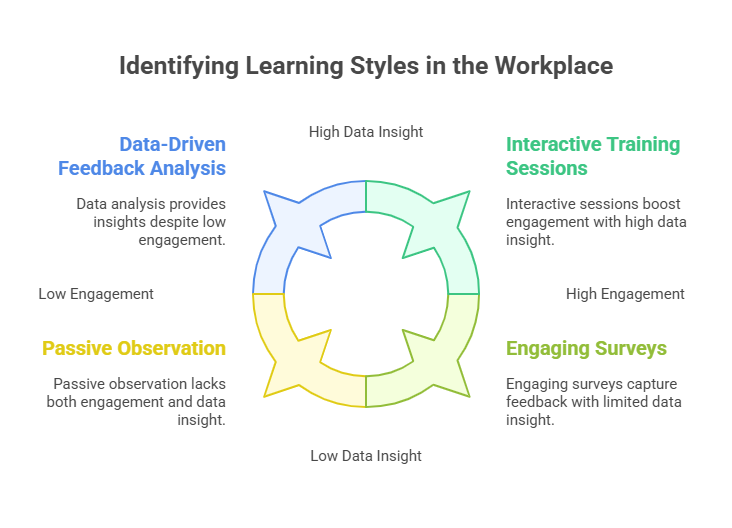
It's essential to know how your team learns. This helps you give better training. Here are four simple ways to find out:
1. Use Simple Training Tools
Tools like Cloud Assess allow you to train in various ways, through videos, pictures, or short quizzes. You can also see what people use most.
If someone watches videos but skips reading, they may learn best by seeing or hearing the information. This helps you choose what works for them.
2. Ask for Feedback
After training, ask your team what they liked. Use short surveys, suggestion boxes, or just have a quick chat. Their answers can show you which learning style suits them best. You'll also see what you can do better next time.
3. Look at the Data
Check how people do in training. Who finishes quickly? Who takes more time? Who scores well? This can help determine if the training style meets their needs. You can then adjust the format to assist them better.
4. Talk One-on-One with Your Team
Sit down with your team and ask simple questions. What kind of training helps them most? Do they prefer videos, reading, hands-on activities, or working in groups?
Just listen. These chats also show how they use what they've learned at work.
When you understand how someone learns, it's easier to help them grow. It also shows you care, and that means a lot.

Frequently Asked Questions
What are learning styles, and why do they matter?
Different types of Learning styles are just the way you learn best. Some people learn by seeing. Others by hearing, reading, or doing things. When you know your style, learning feels easier. You remember more, and studying gets less stressful.
How can teachers or course creators support students with diverse learning styles?
Teachers can mix things up. They can use videos, sounds, games, and hands-on tasks. They can let students pick how they do some work. Providing kind and clear feedback is also really helpful.
How can students figure out their learning styles?
Try it all. Watch videos. Read books. Listen to the audio. Build or move things. Then ask yourself, what helped you remember most? That's probably your main style.
Do other factors also affect learning?
Yes! Things like your mood, your energy, your space, and even your teacher matter. Learning style helps, but it's just one part. A calm mind and good support also make a significant difference.
Conclusion
No matter how you learn best, whether by watching, listening, doing, or reflecting. Understanding your learning style can be a powerful tool for success in online education. With so many flexible tools and platforms available today, you don’t have to fit into a single mold. Instead, you can match your learning preferences with the right methods and content formats, making the entire learning experience more engaging, effective, and enjoyable.
For course creators, this means designing with inclusivity in mind. And for learners, it means taking control of how you absorb information. Embrace your style, explore new ones, and keep evolving. The best learning happens when it's personalized and now more than ever, that's possible.

